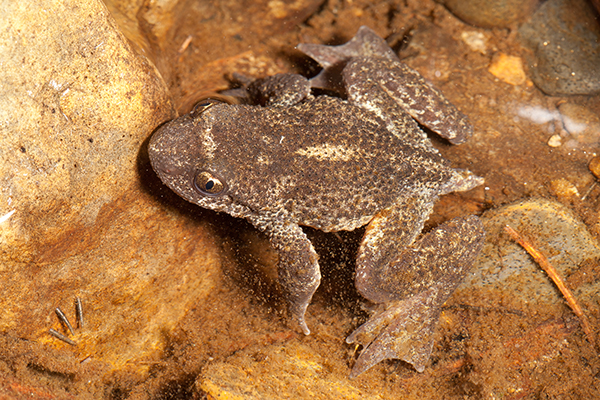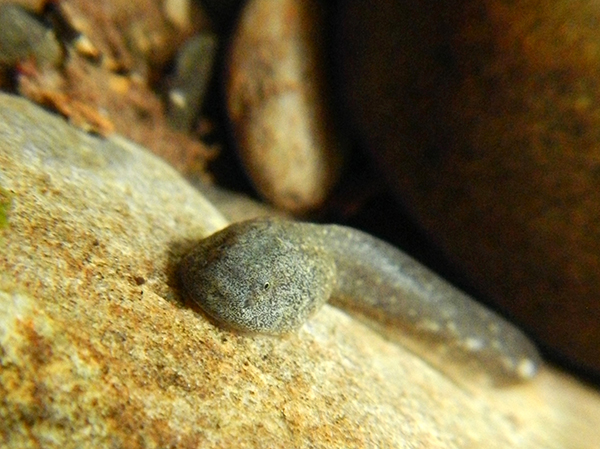Home »

Looking for an ancient frog with modern genetics
Parks Plates and Trust support innovative ecological study in Gilnockie Provincial Park
By Ian Adams
The helicopter nestles into the natural forest opening atop a ridge in British Columbia’s Gilnockie Provincial Park. As the rotors slow, biologists and BC Parks staff jump out and start gathering gear. We’ll bushwhack our way down slope with the goal of intercepting a small tributary stream before following it to the incised valley bottom where the helicopter will pick us up again. Then we’ll do it all over again with another stream. Our day of “heli-hiking” in the Gilnockie has begun!
Our hope is that the brook is home to a cryptic, little-known amphibian that lives in a few small mountain streams in B.C.’s Kootenays: the Rocky Mountain Tailed Frog.
If it is here, Gilnockie Provincial Park will be the only formal protected area in British Columbia – or all of Canada for that matter – to include Rocky Mountain Tailed Frog on its species list. As a Threatened species under Canada’s Species at Risk Act and blue-listed in B.C., protected habitat is important to its future.
Despite tailed frogs being our goal, we don’t expect to see one. Sure, we’ll casually look in the stream, maybe turn a rock or two but looking just slows us down and we have more streams to visit today. Tailed frogs and their tadpoles are masters of camouflage, hiding amongst cobbles and under stream banks. So rather than finding the entire animal, we’re looking for something that cannot hide: their DNA.
“Tailed frogs, both Rocky Mountain and the related Coastal species, are notoriously difficult to survey,” says project co-leader Jared Hobbs. “Previously, our knowledge on which streams they inhabit relied on labour-intensive visual searches that involved field workers literally crawling up these cold mountain streams. It was hard work that we knew often missed frogs and tadpoles.”
 Hobbs is a leader of environmental DNA, known as eDNA, in British Columbia. The method involves sampling streams, lakes or rivers to collect tiny bits of exogenous DNA free-floating in the water. Remarkable advances in genetic testing allow biologists to test those samples for the DNA from a given species.
Hobbs is a leader of environmental DNA, known as eDNA, in British Columbia. The method involves sampling streams, lakes or rivers to collect tiny bits of exogenous DNA free-floating in the water. Remarkable advances in genetic testing allow biologists to test those samples for the DNA from a given species.
Using a technique known as quantified or real time polymerase chain reaction (qPCR), short sequences of a species’ unique genetic code can be artificially multiplied in the lab to measurable amounts.
If their DNA is present, it’s a virtual lock that the species is there to slough it off into the water. If the species is not present in the water, there is no DNA to amplify and the test is negative.
But first we have to get to the stream. Today is not the high-end heli-hiking tour popular in alpine areas. This is no walk in the park, even going downhill.
Gilnockie Provincial Park was created in 1995 as part of the Commission on Resources and Environment process (CORE). It protects old forests that are highly diverse for the East Kootenay. Large trees of Douglas-fir, western larch, western red cedar grow on these steep slopes, joined by spruce and hemlock in the cool, damp valley bottoms. On the ridge tops, natural openings like the one we landed in are interspersed with pine forests and natural high elevation grasslands.
Because its management objective is primarily environmental protection, there are no recreational facilities or trails in Gilnockie. There are no roads that access it. This is a wilderness park.
We slip and slide our way down steep slopes, clambering over wind-thrown trees left wet and slippery from the rain showers that have persisted on and off throughout yesterday and today.
 Occasionally we stop to marvel at groves of trees that are more reminiscent of coastal or interior rainforest areas than the otherwise relatively dry East Kootenay. This is indeed a special place and why Gilnockie was made a Provincial Park.
Occasionally we stop to marvel at groves of trees that are more reminiscent of coastal or interior rainforest areas than the otherwise relatively dry East Kootenay. This is indeed a special place and why Gilnockie was made a Provincial Park.
Rocky Mountain Tailed Frogs are considered to be a vestige of previous times when the Pacific coast was nearby. For some 10 million years in the early Cenozoic era, after the extinction of dinosaurs and before the rise of the Coast Mountains, these (now inland) areas were wet coastal forests.
That tailed frogs would have been part of this long-ago ecosystem is not a stretch, for today’s species are the current embodiment of an ancient lineage. Among the oldest known frogs in the world, they branched off from a common amphibian ancestor almost 250 million years ago. This evolutionary isolation from other frogs combined with their mountain stream habitat has left them with some very unique adaptations.
They are the only frog in North America that does not vocalize. Indeed, they have no eardrum to hear any sounds, for most sound gets muffled out of their constantly noisy stream environment. Their anatomy is different from all other frogs, affecting how they hop on land and kick in water.
And about that tail… Let’s just say it’s only on males and it’s not a tail. Tailed frogs are the only amphibians to use internal fertilization because external fertilization of eggs (as all other frogs do) just wouldn’t work in a fast-moving mountain stream.
At length, the hillside we have been charging our way down levels out and at the bottom of the slope we find our stream. Standing beside this stream, in the quiet shadow of old growth trees in the light rain is a poignant moment for all of us in a park that seldom sees a human presence.
Previously, such applied ecological work very rarely, if ever occurred in BC Parks.
 However, new revenue provided by the BC Parks License Plate program has allowed such projects to take place.
However, new revenue provided by the BC Parks License Plate program has allowed such projects to take place.
When Amanda Weber-Roy, Conservation Specialist with BC Parks’ Kootenay Region, learned that we had documented Rocky Mountain Tailed Frog for the first time in the Gilnockie Creek drainage just upstream of the park last year, she was quick make the connection and applied to access the new funds. Columbia Basin Trust supported the project in 2017 and 2018 with their Environmental Grant program.
“Funding from the BC Parks plates has opened up wonderful new opportunities like this,” Weber-Roy noted. “Our ability to conduct on-the-ground surveys for species-at-risk like Rocky Mountain Tailed Frog allows us to more fully understand the ecological values that BC Parks support.”
“The first part of protecting BC’s ecological heritage is knowing what’s out here,” added Craig Browne, Senior Park Ranger in the Kootenay Region. “In many cases we just don’t know what’s there, especially for lesser known species like tailed frogs.”
With a pre-arranged helicopter pickup site still well below us, we get to work and sample our water. Two one-litre water bottles are carefully filled and labelled at each site, then packed away as we make our way down the stream to the Gilnockie mainstem.
We see neither frog nor tadpole but that doesn’t matter. The real story lies in the microscopic particles in the bottles. Once filtered and sent to the lab, the answer will come in the future. Like 20th Century photography when you had to send your film away for developing, the anticipation of results lies in wait over the weeks ahead.
For now, we are just relieved to find the stream has water. The first requirement of tailed frog habitat is permanent water and not all of these side streams flow year-round. Unlike other frogs whose tadpoles metamorphose into adults within months of hatching, Rocky Mountain Tailed Frog remains a larval tadpole for at least three years. Their mouths are modified into suckers so they can latch onto rocks and boulders in their fast-moving streams, grazing on algae and dining on diatoms while hiding in crevices between rocks.
 Even after metamorphosing to adult form, tailed frogs don’t breed until age seven or more. Such long-lived, slow reproductive strategies are very rare in amphibians and contribute to the challenges of their conservation. For the tadpoles, it means that streams must remain watered year-round or they will not survive.
Even after metamorphosing to adult form, tailed frogs don’t breed until age seven or more. Such long-lived, slow reproductive strategies are very rare in amphibians and contribute to the challenges of their conservation. For the tadpoles, it means that streams must remain watered year-round or they will not survive.
Lower down, the stream tumbles through a canyon of moss-covered rock toward the Gilnockie mainstem. There, the valley widens as Gilnockie Creek slowly winds its way over beaver dams amongst dense alder thickets. A mink slips into a side channel as we radio the helicopter for a pickup, toeing into a grassy area so we can scramble on board and do it all over again.
 We sample three different streams in Gilnockie today, other streams that looked promising on the map show little sign of having water or access to land the helicopter just isn’t feasible. Gilnockie doesn’t easily yield its secrets.
We sample three different streams in Gilnockie today, other streams that looked promising on the map show little sign of having water or access to land the helicopter just isn’t feasible. Gilnockie doesn’t easily yield its secrets.
The day isn’t over though. Back home, a few more hours of work lie ahead. The water samples must be filtered the same day to preserve the DNA.
Our creek water is pulled through a special membrane with pores small enough to trap any DNA segments without damaging them.
Once filtered, the samples are sent to Dr. Caren Helbing’s lab at University of Victoria for testing. A leader in eDNA testing methods, Dr. Helbing’s qPCR techniques are among the most rigorous in the world. Their work carefully isolates any DNA present on the filter and begins the qPCR process that will test whether Rocky Mountain Tailed Frog is in Gilnockie Provincial Park.
Early November: The lab calls and has our results.
One of the three streams tested positive for Rocky Mountain Tailed Frog eDNA! Another stream may be worth looking at again because of the rain that had fallen immediately prior to our testing. As well as raising with stream levels, rain also increases the possibility of a false negative test due to lower eDNA concentrations. For now though with at least one positive test, we can say that Gilnockie Provincial Park is home to Rocky Mountain Tailed Frog.
In the past five years, Jared Hobbs and I have found Rocky Mountain Tailed Frog in five previously unknown East Kootenay watersheds using eDNA. Without the genetic testing, it’s unlikely any of these populations would have been found. We can now add Gilnockie Provincial Park to the list.
The result wouldn’t have been possible without combining two novel approaches – BC Parks’ License Plate program putting money back into provincial park conservation and modern genetic testing – to find an ancient frog species.
Lead image: Rocky Mountain Tailed Frog, Ascaphus montanus, Moyie River, East Kootenay, BC, Canada. Photos courtesy Ian Adams
– Ian Adams is a Registered Professional Biologist based in Cranbrook. Previous years’ funding for the Rocky Mountain Tailed Frog eDNA project was provided by BC’s Forests, Lands, Natural Resource Operations and Rural Development’s Land Based Investment program.







